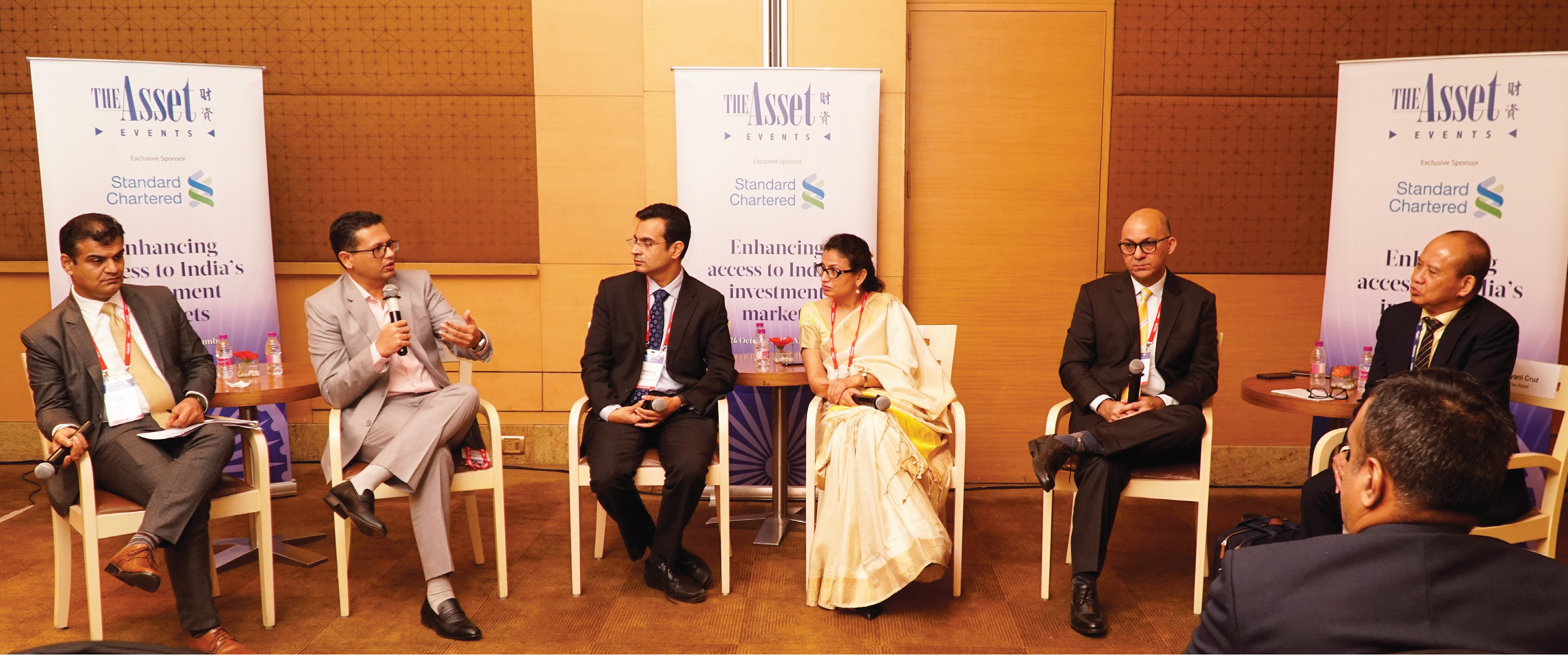THE asset management industry in India has come an extremely long way over the last 20 years. The industry has grown from almost nothing to a size where domestic SIP (Systematic Investment Plan) flows on a monthly basis is approximately US$1.5 billion. However, with approximately 1.3 billion people, the market in India remains largely untapped and there is opportunity to start moving to both retail and institutional investors, yet the risk appetite and awareness levels are of a very different nature between the investor class.
“The number of retail mutual fund or asset management investors is practically not even equal to people who pay income tax. So, the kind of opportunity that we are looking at is huge,” says Keerti Gupta, chief operating officer, Aditya Birla Sun Life Asset Management, during a panel discussion organized by The Asset in association with Standard Chartered Bank. “What we need to look at is what is the risk reward profile of the available investor in this country and how do we engage them, and on these aspects, how do we expand the geographical reach inshore and make it far more inclusive.”
India has three broad market segments – Mutual Funds, Portfolio Management Service (PMS) and Alternative Investment Funds (AIF). Mutual funds, the largest sector, has grown significantly over the last two decades, yet the PMS and AIF sectors are relatively new having only taken off over the last five to seven years. “Initially it was just equity or investment grade debt, but that has diversified in terms of asset classes, especially in the AIF space. However, to grow the domestic AIF business, you need long term institutional capital which is not available locally, so it has to come from overseas,” explains Shahzad Madon, head alternative assets, Nippon India Alternate Investments.
AIF is a new asset class or type of structure which has been allowed by the Securities and Exchange Board of India (SEBI). It is effectively a pooling vehicle that can take investments on with or without leverage [depending on the type of AIF]. AIF is the Indian equivalent of a hedge fund – an alternative asset class where people can go beyond the traditional asset management, mutual fund product to more sophisticated categories.
“There are three categories [of AIF]; category I is more for venture capital or social development kind of structures. Category III can take leverage and effectively get into sophisticated risk-based strategies such as arbitrage, long-short, derivative products etc. Then there is category II, which is effectively anything that doesn’t fit into category I and category III,” says Chaitanya Joshi, executive director – head, India securities services business, Standard Chartered Bank. “Typically, we’ve seen a lot of debt raising and corporate funding, bond funding etc happening through the category II route, as well as a lot of long only, hold to maturity kind of equity investments.”

AIFs have some specific requirements mandated by the Securities and Exchange Board of India (SEBI); they require a minimum investment of $10 million rupees (US$150,00) from the investor. Approximately US$3 million of capital is required to start a fund, and there are other restrictions as well, according to Chaitanya. The idea is to insulate AIFs to the high-net worth individuals, or institutional categories, who have a better understanding of the risk profile of this vehicle, and of the substantial returns it can generate.
However, since the AIF regulations were issued in 2012 there has been some uncertainty in terms of the taxability of AIFs. For the first two years there was no certainty as to what will be the characterization of income, who will get taxed, will it be taxed, at the AIF level or at the investor level. In 2014 that was clarified as far as category I and category II AIFs are concerned - they will be tax transparent if those AIFs are not carrying out business income.
Exactly what is classified as business income and what is not is, again, a matter of interpretation, and there remain no set guidelines. There have been discussions with the Central Board of Direct Taxes and the tax administration body to clarify what constitutes capital gains and what constitutes business income, but uncertainty surrounds that as well. And there is still no set taxation regime for category III AIFs.
“Funds prefer to categorize themselves as not carrying on business so as to avail the benefit of being treated as tax transparent and let the investors be assessed directly (though there are withholding obligations for the fund). Then we see hedge funds who deal in listed securities or apply arbitrage kind of strategies - there the classification is more like a business income, taxed at the fund level, and the expenses the fund incurs in earning that income are eligible for reduction to compute taxable business income,” says Rinkesh Devnani, director, B. S. R. & Co.
The recent budget of 2019 put a spanner in that, however, because now the business income for AIFs is actually inviting a higher surcharge and therefore funds who are thinking of employing category III business strategies are back to the drawing board. And in terms of trying to bring certainty to this entire space, the government has taken steps to streamline the process to allay the uncertainties around AIF taxation, and this is happening at a very fast pace.
The category of investor that AIFs are primed for is family offices or high-net worth individuals - people who have experience in the capital market, or have a good understanding of financials and these types of strategies. “These products are extremely complex for anybody to understand, and they are pretty volatile in nature, so it is extremely important that you get people who are mature in years with a good amount of financial literacy, and investor education therefore becomes very important if you want to expand this particular market,” explains Keerti.
Vaibhav Sanghavi, co-chief executive officer, Avendus Capital Alternate Strategies, takes a different perspective and does not necessarily agree that the products have to be volatile purely because the flexibility provided by the guidelines being introduced by SEBI actually allows a very risk adjusted product by actively reducing or increasing the volatility.
“When we do a strategy, something like an absolute return, what we have done is basically reduce the volatility to one third of your index while delivering a return which is pretty much consistent. So, the guidelines actually give you flexibility to operate products, from a lower ball product to a higher ball product, and it is extremely important as an asset manager, as an AIF manager, to be transparent in the strategy you are using,” says Vaibhav.
One of the chief things that investors normally look at is certainty; undoubtedly there are many challenges that AIFs face moving forwards, especially from the tax perspective, and increased certainty around these expenses will go a long way to deepening the market. Up to now the industry has grown phenomenally well, but the potential to grow even further is huge, providing the tax regulations are there. The industry is actively working with the government to resolve these issues, and there is optimism that they can be addressed sooner rather than later.





.jpg)
.jpg)


